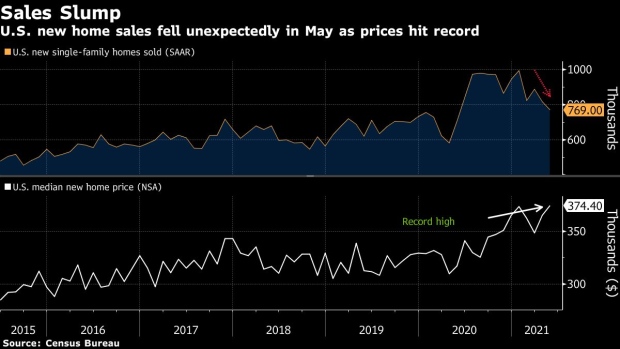Sales of new U.S. homes dropped unexpectedly in May as elevated home prices continue to weigh on affordability and builders rush to replenish inventory.
Purchases of new single-family homes fell 5.9 per cent to a 769,000 annualized pace after an downwardly revised 817,000 in April, government data showed Wednesday. The median estimate in a Bloomberg survey of economists called for a 865,000 rate.
Shipping bottlenecks and higher input prices have held back homebuilding, contributing to skyrocketing prices for the limited supply of homes available. A silver lining of the report was data showing new-housing inventory continued to increase, though about a third of those homes have yet to be built.

Homebuilder stocks slipped following the report. An S&P index of 16 homebuilders dropped as much as 2.5 per cent on the data, its biggest intraday decline in two weeks.
Ian Shepherdson at Pantheon Macroeconomics said the sales drop might be a sign that demand in the suburbs has fallen as COVID-19 fears have faded, going so far as calling the end of the boom. By contrast, Stephen Stanley at Amherst Pierpont Securities calls it “mostly an anomaly.”
“Aside from surging home prices squeezing some potential buyers out of the market, I do not have a good explanation for the latest fall,” Stanley wrote. “Anecdotally, we know that demand for homes remains robust, so I am pretty sure this is not an indication of a softening market.”
There were 330,000 new homes for sale in May, the most since July 2019. At the current sales pace, it would take 5.1 months to exhaust the supply of new homes, compared with 4.6 months in the prior month.
The median sales price rose to a record US$374,400. Mortgage applications have fallen sharply since January, suggesting that demand for homes is slowing.
The number of homes sold in May and awaiting the start of construction -- a measure of backlogs -- was little changed from a month earlier at 276,000, Wednesday’s report showed. The total number of homes sold with construction underway eased to 305,000 in May.
A separate report Tuesday showed that existing home sales fell for a fourth straight month in May, held back by lack of inventory and record-high prices.
Digging deeper
- Sales across U.S. regions were mixed, with the Midwest seeing no change and the South posting a decline. Home sales in the Northeast showed a large increase
- New-home purchases account for about 10 per cent of the market and are calculated when contracts are signed. They are considered a timelier barometer than purchases of previously-owned homes, which are calculated when contracts close
- The new-homes data are volatile; the report showed 90 per cent confidence that the change in sales ranged from a 24.5 per cent decline to a 12.7 per cent increase









